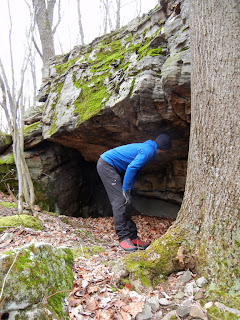On September 10, .. I visited the library in Iola, Allen County, Kansas where I was able to find cemetery transcriptions and newspaper obituaries for some descendants of Minerva Fatima (Joslin) Knight, daughter of my 3rd great-grandparents Lysander and Lydia (Robison) Joslin.
Minerva Fatima Joslin was born January 7, 1859 in Whitley County, Indiana. At the age of 17, on March 16, 1876, Minerva was married in Whitley County to 20 year old William John Knight. The minister who married them was Price Goodrich, the brother of Minerva's grandmother, Abigail (Goodrich) Joslin. The next year Minerva and William moved to Barton County, Kansas along with her parents and the majority of her brothers and sisters. (Her sister and my 2nd great-grandmother, Malissa Joslin Brubaker, was the only sibling that remained in Whitley County, Indiana.)
A William Knight was found in Beaver Township (page 490) in the 1880 census with wife Mary (this is presumed to actually be Minerva). Also listed with William were two daughters, Mary A. age 1, and Nina G. age 5/12. These fit the ages of their first two children, a son Merlin Andrew was born in October 1878 and a daughter, Nellie Gertrude was born on December 22, 1879. If this is really the right family, the census enumerator sure had some difficulty with their names! (A third child, Hale Vernon would be born August 12, 1896.)
In May 1899, Minerva and William were living in Keighly, Butler County, Kansas (when her father died at her home on May 1st). However, the family was found in Reeder Township, Anderson County, Kansas (page 305) in the 1900 census. Listed was William (head of household), his wife Minerva, 3 year old son Hale, and a boarder, William Beck.
They must have moved to Iola, Allen County, Kansas soon after the 1900 census as that is where William passed away on January 2, 1902 at the age of 46. After William's death, Minerva was married to J. N. Storey (date and place of marriage not yet known) and reportedly died on May 12, 1905 (also at age 46) in a wheelchair on the street in Hot Springs, Arkansas. I was unable to find an obituary for Minerva in the Iola newspaper. I haven't checked the Hot Springs newspapers yet. After their deaths, their young son Hale lived with his sister Nellie and her husband, Bert Sutton. Minerva and William are both buried in the Old Cemetery in Iola, Allen County, Kansas.
The notice of the death of William John Knight was published on January 6, 1902 in the Iola Daily Register.
W. J. Knight, who lives in Brooklyn Park, and who has been employed as a carpenter at the Standard Acid Works, dropped dead from heart failure as he was preparing to begin work at 7 o'clock this morning. The doctor and coroner agree that death was instantaneous and the remains were taken to Culbertson's undertaking rooms.
Mr. Knight seemed to be in his usual good health when he appeared at the works this morning. He greeted his fellow workmen pleasantly and at the sound of the whistle laid his had on an upright beam, preparatory to ascending to the place where he was working. Then the blow came and without an outcry he sank to his knees and then to the floor. Several men saw him fall and hurried to his side. Apparently he was dead when they reached him, but they carried him to the open air and did what they could in the hope of reviving him. Dr. Coffman was telephoned for and soon arrived on the scene, but could do nothing and he stated that Mr. Knight must have died almost as soon as he reached the ground. Coroner F. D. Teas was notified and viewed the remains, later authorizing the removal to an undertaking parlor.

Large center stone with father and mother stones to the left and right. In the Old Cemetery in Iola, Allen County, Kansas.

Knight (across top of the stone)
W. J. KNIGHT / 1855-1902 / AT REST
MANERVA F. / HIS WIFE / 1859-1905

Another stone, that of a great-grandson, is set in the same plot, in front of and to the left of the “Father” stone. Ronald was the son of Helen Sutton and her husband, Gerald Curtis.
RONALD STEVEN / CURTIS / APR 1, 1943
William and Minerva (Joslin) Knight had three children:
1.
Merlin (Merle) Andrew Knight was born in October 1878 and died March 8, 1930. He was married on October 26, 1899 in Butler County, Kansas to Carrie Thompson. She was born in August 1881 and died in October 1971. They had four children: Harry, Leota, Ruby, and Opal Knight.
2.
Nellie Gertrude Knight – will be the subject of a future post.
3.
Hale Vernon Knight was born August 12, 1896 in Butler County, Kansas and died on January 30, 1947. He was married to Alma (maiden name not known) about 1918 and they had three children: Hester, Hale and Mary Knight. An online obituary for Alma (The Wichita Eagle dated May 23, 1992) stated that she died May 20, 1992 at the age of 96 and was a retired teacher. Survivors included a son Hale of Everett, Washington and a daughter Mary K. Merrill of Harlingen, Texas. Also six grandchildren and nine great-grandchildren.


 As I left Indiana on Sunday morning, I wasn't too concerned with what the weather was doing in Kentucky and Tennessee. According to reports, the ice and snow would have finished falling before I got there. And the reports were right, but it sure did leave a "mess" all along the I-40 corridor from Oklahoma to the Carolinas and Virginia. Interstate 65 was clear all the way but through Nashville the exit and entrance ramps were in horrible shape and from what I saw on the news many of the secondary roads were still snow covered and icy this morning.
As I left Indiana on Sunday morning, I wasn't too concerned with what the weather was doing in Kentucky and Tennessee. According to reports, the ice and snow would have finished falling before I got there. And the reports were right, but it sure did leave a "mess" all along the I-40 corridor from Oklahoma to the Carolinas and Virginia. Interstate 65 was clear all the way but through Nashville the exit and entrance ramps were in horrible shape and from what I saw on the news many of the secondary roads were still snow covered and icy this morning. Storm clouds have moved in towards late afternoon each of the past few days. Sometimes rain falls, sometimes it doesn't. Southwest Montana July 12, ...
Storm clouds have moved in towards late afternoon each of the past few days. Sometimes rain falls, sometimes it doesn't. Southwest Montana July 12, ...

 The view from the valley floor, midway along the Pa'rus Trail.
The view from the valley floor, midway along the Pa'rus Trail. The peak known as "The Watchman" towers over the Lower Canyon. The Virgin River flows through the canyon and over thousands of years has helped create this marvelous place.
The peak known as "The Watchman" towers over the Lower Canyon. The Virgin River flows through the canyon and over thousands of years has helped create this marvelous place. The wind-whipped water from one of the waterfalls in the Upper Canyon.
The wind-whipped water from one of the waterfalls in the Upper Canyon. A grove of trees in the Upper Canyon area, caught in the fleeting rays of sunshine.
A grove of trees in the Upper Canyon area, caught in the fleeting rays of sunshine. The view from my campsite, near sunset.
The view from my campsite, near sunset.
 When Bryan Hollingsworth phoned to tell me that "our" frame was back from the painter's, I dropped what I was doing, grabbed my camera and was there within minutes. For weeks I had been nervously anticipating the results of my emphatic description of what I wanted this frame to look like - a description presented in an illustrated 3-page document, then further clarified in a tête-à-tête with the painter. He must have thought I was insane to wax lyrical about the precise shade of "stormy seas" I had in mind. But no matter, because it's done and it looks just as I had imagined!
When Bryan Hollingsworth phoned to tell me that "our" frame was back from the painter's, I dropped what I was doing, grabbed my camera and was there within minutes. For weeks I had been nervously anticipating the results of my emphatic description of what I wanted this frame to look like - a description presented in an illustrated 3-page document, then further clarified in a tête-à-tête with the painter. He must have thought I was insane to wax lyrical about the precise shade of "stormy seas" I had in mind. But no matter, because it's done and it looks just as I had imagined!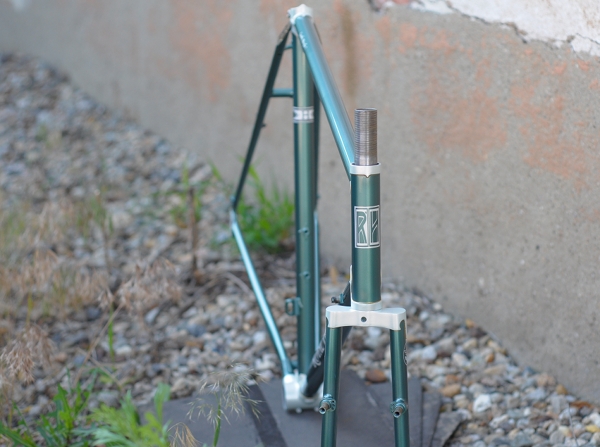 So what exactly is this frame? I have mentioned before in passing that I am collaborating with Bryan of Royal H. Cycles on a classic randonneuring bicycle. I provided the geometry and tubing specs (don't worry, I had a lot of help), came up with the colour scheme, and specced the components. Bryan built the frame with his signature touches, and will be putting the bike together - including internally routed lighting. In other words, he did the real work while I talked, gesticulated, sent emails, and took pictures. It takes all kinds.
So what exactly is this frame? I have mentioned before in passing that I am collaborating with Bryan of Royal H. Cycles on a classic randonneuring bicycle. I provided the geometry and tubing specs (don't worry, I had a lot of help), came up with the colour scheme, and specced the components. Bryan built the frame with his signature touches, and will be putting the bike together - including internally routed lighting. In other words, he did the real work while I talked, gesticulated, sent emails, and took pictures. It takes all kinds.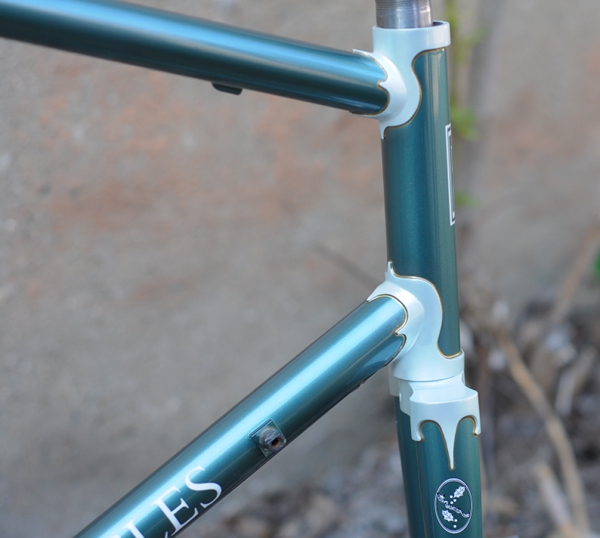 It's difficult to tell at the drawing board how a frame will really look once it is finished, but this is pretty much what we hoped it would look like. The Everest lugset and Grand Bois fork crown are just perfect together.The tubing is True Temper OX Platinum, withKaisei Toei Special fork blades.
It's difficult to tell at the drawing board how a frame will really look once it is finished, but this is pretty much what we hoped it would look like. The Everest lugset and Grand Bois fork crown are just perfect together.The tubing is True Temper OX Platinum, withKaisei Toei Special fork blades.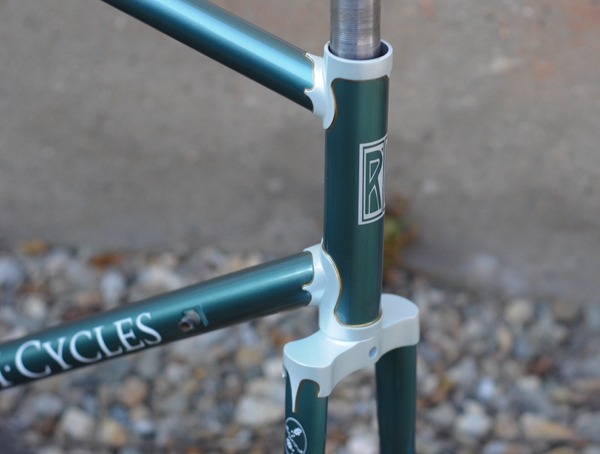 This is a classic randonneuringframe in the sense that it has low trail geometry and is built for 650B wheels with wide tires. Specifically, we will be using the Grand Bois Hetres, and you can see them fitted onto the "naked" frame here. The build will be fairly classic and high quality, but nothing too flashy. We are going to try to keep the weight down as well. The frame and fork themselves feel very light.
This is a classic randonneuringframe in the sense that it has low trail geometry and is built for 650B wheels with wide tires. Specifically, we will be using the Grand Bois Hetres, and you can see them fitted onto the "naked" frame here. The build will be fairly classic and high quality, but nothing too flashy. We are going to try to keep the weight down as well. The frame and fork themselves feel very light.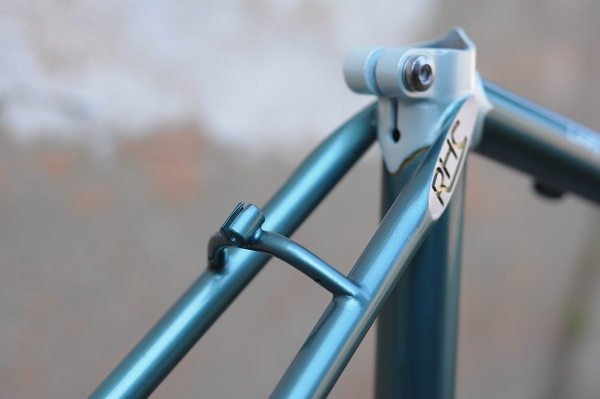 Bryan had just ordered these custom RHC (Royal H Cycles) end caps for seat stays, and this is the first frame that will have them. He also made the cantilever cable hanger.
Bryan had just ordered these custom RHC (Royal H Cycles) end caps for seat stays, and this is the first frame that will have them. He also made the cantilever cable hanger. Front derailleur hanger.
Front derailleur hanger.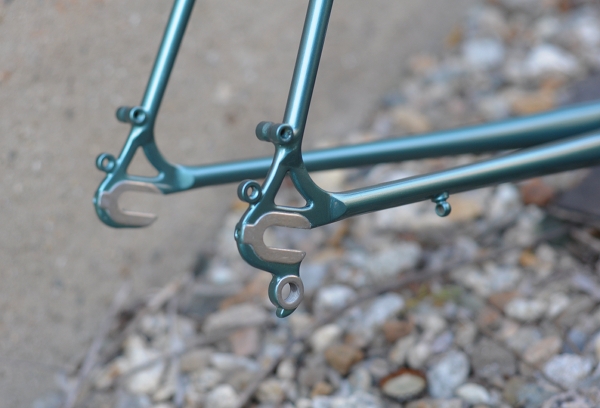 Zink-plated dropouts, eyelets for fenders and rear rack.
Zink-plated dropouts, eyelets for fenders and rear rack.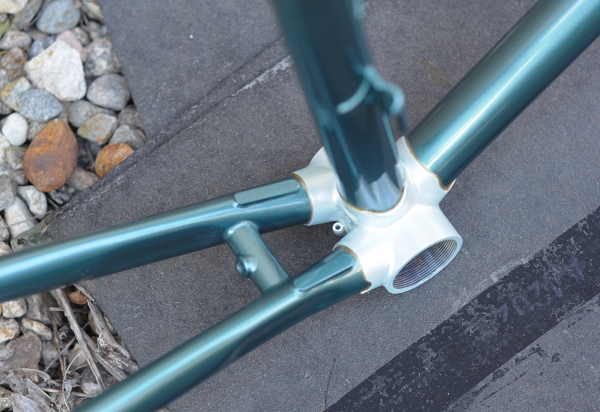 Bottom bracket, cable routing, stainless kickstand plate. There is much more to this frame, but I will save it for when the bicycle is finished!
Bottom bracket, cable routing, stainless kickstand plate. There is much more to this frame, but I will save it for when the bicycle is finished!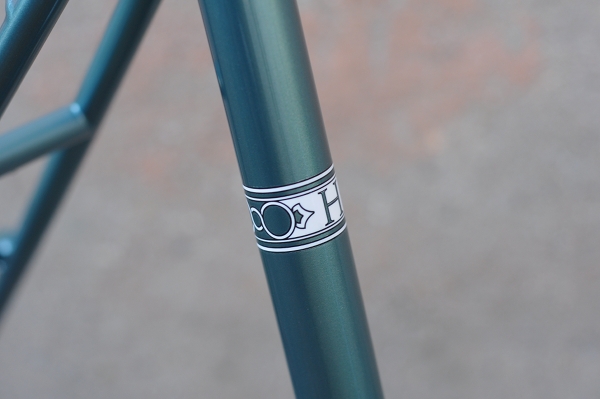 Bryan has several options for decal designs that he uses, and I wanted the frame to have aspects from different ones. So the head tube insignia design is from one set, while the downtube insignia is from another, and I love the way it all came together here. I also really wanted this band around the seat-tube, which reminds me of a vintage candy wrapper.
Bryan has several options for decal designs that he uses, and I wanted the frame to have aspects from different ones. So the head tube insignia design is from one set, while the downtube insignia is from another, and I love the way it all came together here. I also really wanted this band around the seat-tube, which reminds me of a vintage candy wrapper. The main frame colour is a slate-blue-green metallic paint with very fine pearlescent particles. I suspect that this is the same or a similar paint as what Mercian uses for their polychromatic colour family, which they describe as resembling "the underside of tin foil." While it's not for everyone, I am crazy about this finish, and the colour really does resemble a stormy sea. The lugwork is off-white with a similar metallic shimmer as the main frame colour, resulting in a sort of mirror finish effect. In person this creates an interesting illusion, where the lugs sometimes look white, and at other times resemble the main frame colour. The lugwork is subtly outlined in gold.
The main frame colour is a slate-blue-green metallic paint with very fine pearlescent particles. I suspect that this is the same or a similar paint as what Mercian uses for their polychromatic colour family, which they describe as resembling "the underside of tin foil." While it's not for everyone, I am crazy about this finish, and the colour really does resemble a stormy sea. The lugwork is off-white with a similar metallic shimmer as the main frame colour, resulting in a sort of mirror finish effect. In person this creates an interesting illusion, where the lugs sometimes look white, and at other times resemble the main frame colour. The lugwork is subtly outlined in gold.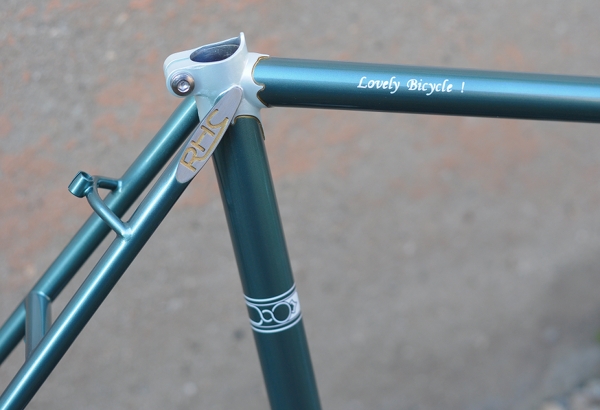 Before this bicycle is sent off to the customer, I will be test riding it for a few weeks and inviting a couple of more experienced cyclists to test ride it as well. Neither the framebuilder, nor the customer, nor myself have any idea what to expect from this bike and that is part of the excitement. We all wanted to try a classic randonneuring bicycle, and creating one ourselves was an interesting way to make that happen.I will post more about this bike once it is built up, and will most likely be writing about it forBicycle Quarterly sometime later this year, so stay tuned. A big thank you to everyone who helped make this happen. It is a beautiful experiment, and I can't wait to find out how it rides!
Before this bicycle is sent off to the customer, I will be test riding it for a few weeks and inviting a couple of more experienced cyclists to test ride it as well. Neither the framebuilder, nor the customer, nor myself have any idea what to expect from this bike and that is part of the excitement. We all wanted to try a classic randonneuring bicycle, and creating one ourselves was an interesting way to make that happen.I will post more about this bike once it is built up, and will most likely be writing about it forBicycle Quarterly sometime later this year, so stay tuned. A big thank you to everyone who helped make this happen. It is a beautiful experiment, and I can't wait to find out how it rides!


 The weather here has been awful since I've returned from Vienna. So while I've used my bicycle to get where I need to go, the long "welcome home" ride I fantasized about does not seem to be in the cards. Stretches like this remind me to take advantage of good weather whenever possible, and so I offer these photos from one of the nicer cycling days we had at the beginning of the month.
The weather here has been awful since I've returned from Vienna. So while I've used my bicycle to get where I need to go, the long "welcome home" ride I fantasized about does not seem to be in the cards. Stretches like this remind me to take advantage of good weather whenever possible, and so I offer these photos from one of the nicer cycling days we had at the beginning of the month.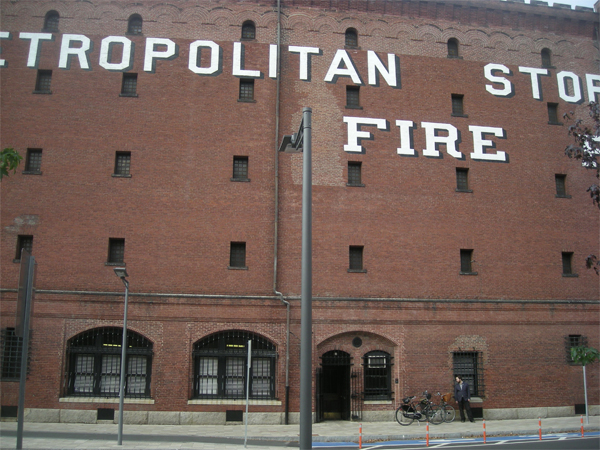 These photos were taken in front of the Metropolitan Storage Warehouse in Cambridge, Mass., which is a local landmark of sorts and has been functioning since 1917.
These photos were taken in front of the Metropolitan Storage Warehouse in Cambridge, Mass., which is a local landmark of sorts and has been functioning since 1917. We do not usually have a good reason to visit this area, but I was intrigued by the Vassar Street bike path controversy that I had read about on
We do not usually have a good reason to visit this area, but I was intrigued by the Vassar Street bike path controversy that I had read about on 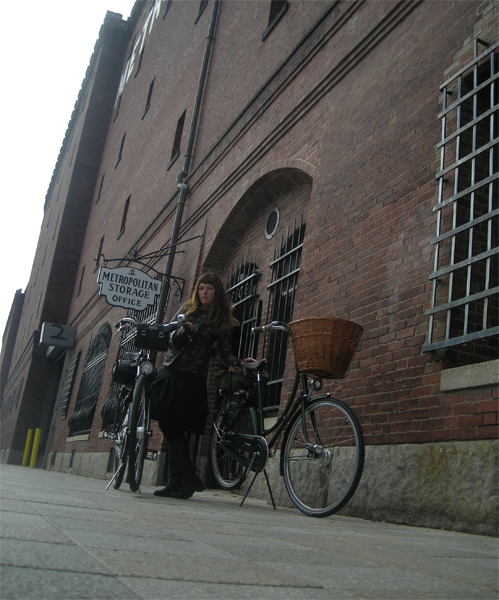 I am not certain what my stance is on the Vassar Street critique; it is a complicated issue. But I do enjoy cycling through the MIT/ Cambridgeport neighborhood during non-traffic hours. When these streets are empty, I feel that the personalities of all the warehouses and industrial sites and contemporary constructions really come out, and the abandoned urban landscape becomes "communicative". Is it all in my head? Maybe so. But that does not make the experience any less interesting.
I am not certain what my stance is on the Vassar Street critique; it is a complicated issue. But I do enjoy cycling through the MIT/ Cambridgeport neighborhood during non-traffic hours. When these streets are empty, I feel that the personalities of all the warehouses and industrial sites and contemporary constructions really come out, and the abandoned urban landscape becomes "communicative". Is it all in my head? Maybe so. But that does not make the experience any less interesting.
 Large center stone with father and mother stones to the left and right. In the Old Cemetery in Iola, Allen County, Kansas.
Large center stone with father and mother stones to the left and right. In the Old Cemetery in Iola, Allen County, Kansas. Knight (across top of the stone)
Knight (across top of the stone) Another stone, that of a great-grandson, is set in the same plot, in front of and to the left of the “Father” stone. Ronald was the son of Helen Sutton and her husband, Gerald Curtis.
Another stone, that of a great-grandson, is set in the same plot, in front of and to the left of the “Father” stone. Ronald was the son of Helen Sutton and her husband, Gerald Curtis. We had some aviation training today and along the way, I was able to snap a few images.
We had some aviation training today and along the way, I was able to snap a few images. 

 me
me 



